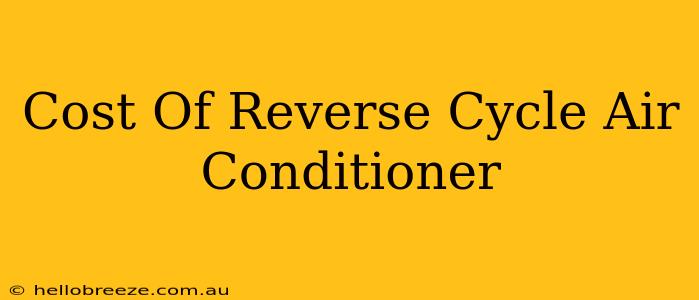Choosing the right reverse cycle air conditioner can significantly impact your comfort and energy bills. But before you start shopping, understanding the cost is crucial. This guide breaks down the various factors influencing the price of a reverse cycle air conditioner, helping you budget effectively and make an informed decision.
Factors Affecting the Cost of a Reverse Cycle Air Conditioner
Several key factors determine the final price you'll pay for a reverse cycle air conditioner. These include:
1. System Size and Capacity:
This is arguably the biggest factor. Larger homes or spaces require higher capacity units (measured in kW or BTU), leading to a higher upfront cost. Don't overestimate or underestimate! Getting the right size is critical for efficiency and comfort. A professional assessment is highly recommended.
2. Brand and Model:
Different brands offer varying features, technology, and levels of efficiency. Established, reputable brands often command a premium price, reflecting their reputation for quality and performance. Consider the warranty offered as part of your assessment. Investing in a higher-quality unit may offer long-term savings.
3. Energy Efficiency Rating:
Reverse cycle air conditioners have energy efficiency ratings (like SEER and COP). Higher ratings signify greater energy efficiency, resulting in lower running costs over the air conditioner's lifespan. While these highly efficient units often have a higher initial cost, the long-term savings can offset the increased upfront investment.
4. Features and Technology:
Modern reverse cycle air conditioners offer a range of advanced features, including:
- Smart home integration: Control your unit remotely via smartphone apps.
- Wi-Fi connectivity: For easy scheduling and adjustments.
- Inverter technology: Provides precise temperature control and improved energy efficiency.
- Air purification: Filters out dust, allergens, and other pollutants.
These additional features increase the overall cost. Consider which features are essential to your needs.
5. Installation Costs:
Installation costs can vary considerably depending on factors such as:
- Accessibility: Difficult-to-reach locations will increase labor costs.
- Electrical work: May involve upgrading your electrical system.
- Ductwork: Existing ductwork may need modifications or replacement.
- Refrigerant type: Different refrigerants may impact installation costs.
Always get multiple quotes from reputable installers to compare prices and services.
Typical Cost Ranges for Reverse Cycle Air Conditioners
While prices vary significantly, here's a general idea of cost ranges:
- Budget-friendly models: Starting from around $1000 - $2000 (excluding installation). These often have fewer features and may be less energy efficient.
- Mid-range models: Typically $2000 - $4000 (excluding installation). Offer a good balance of features and efficiency.
- High-end models: $4000 and above (excluding installation). Feature advanced technology, superior energy efficiency, and extended warranties.
Saving Money on Your Reverse Cycle Air Conditioner
Several strategies can help you keep costs down:
- Shop around: Compare prices and features from multiple retailers and brands.
- Look for rebates and incentives: Government and utility company rebates can significantly reduce the overall cost.
- Consider financing options: Some retailers offer financing plans to make payments more manageable.
- Prioritize energy efficiency: Higher efficiency units may cost more upfront, but save money in the long run.
Remember: The total cost includes not just the unit itself, but also installation and any necessary upgrades. Careful planning and research are essential for making a smart and budget-friendly purchase.

